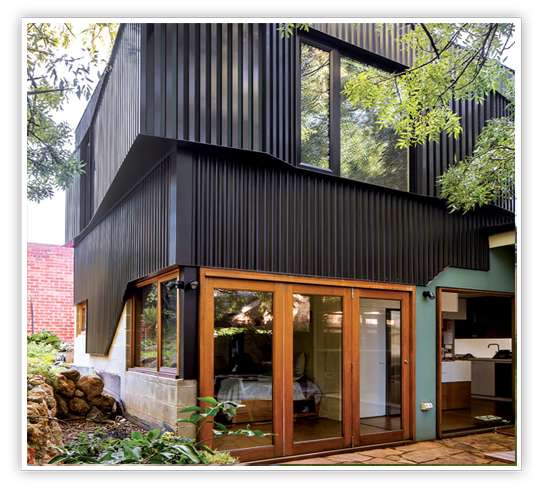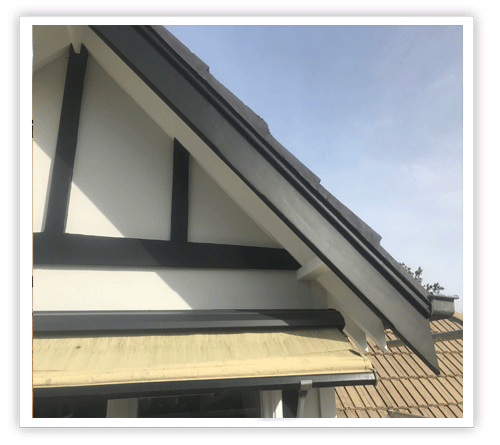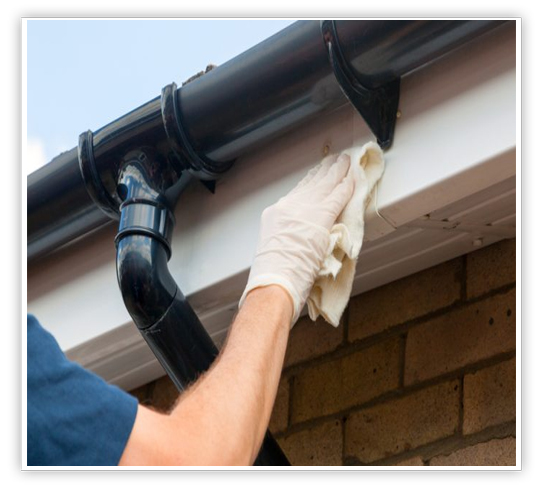Roof fascia boards run along the top edge of a property, at the point where the roof meets the walls. These boards have two main jobs: supporting the lower row of roof tiles and carrying the weight of the guttering.
Roof fascia boards act as a protection for your roof rafters from the elements. The British weather puts these essential structures through their paces with hard winters and warm summers.
uPVC fascias are strong and weather-resistant. Unlike their wood counterparts, uPVC fascias are incredibly low maintenance - they don’t warp and do not require painting or treating. You can also choose the finish that matches your property, from a range of colours and styles.
The roof soffit sits under the fascia board. Its purpose is to provide ventilation inside your roof to stop condensation developing and to prevent dry rot. This can be done in two ways, by using a ventilation system to bring airflow into the roof, or by allowing air in over the top of the fascia board. uPVC soffits come in different colours so you can match the fascia and create a clean line.

Cladding is an outer layer or ‘skin’ that covers the exterior of a building. This external layer protects the building from the elements – stopping rain ingress, cold blasts of wind and temperature fluctuations. It can also be used to add a layer of insulation, further protecting your home from severe temperatures. You can attach it directly to the external wall, as with stone cladding, or you can fix it between timber battens.
Cladding a house can have a dramatic influence on the way the property looks. It can also impact how much maintenance you need to do on your property, for example, painting, sanding or repairing the cladding. uPVC cladding is low maintenance and can help protect problem areas of your exterior brickwork and add a new feature to your home.
Roof bargeboards are used on the gable-end of a house and are positioned at the end of fascia boards. They enclose the end of the fascia to form a ‘box’ that protects the ends of the roof timbers. They provide protection from the weather and keep your roofline dry, helping prevent timber rot.
Bargeboards became popular during the Victorian and Edwardian period and are now available in different designs to suit different property styles. The right bargeboard can be a feature and add a sense of style to your roofline. You can choose a colour and a coating that matches your fascia and soffits.
It is possible to change your damaged or worn bargeboards, but because the tiles are attached to the bargeboard with cement, it may involve replacing some roof tiles as well. The difficulty of the job depends on the age and state of your roof, timber and fascia.


This network of exterior pipes and guttering around your house is essential to make sure water flows away from your property when it rains. The whole system must be watertight and run water away from the walls and the foundations of your home.
Faulty guttering and downpipes can cause damp in your home. Guttering pipes must be fitted correctly so that the joints can cope with thermal expansion and contraction.
There are a range of options for your guttering, including square or rounded pipes and ogee styling, for a more sculpted look. uPVC guttering is also available in different colours and finishes.
Cast iron is a more expensive style of guttering that does not suit every style of property. It is very durable and lasts at least 50 years. Several factors make cast iron an excellent choice on the right house.
Cast iron is widely recycled and lasts a long time in situ. Despite the impact of its manufacturing process, the longevity and the fact that metal can be recycled make it a good environmental choice for guttering.
This light-weight guttering solution is not a common choice in the UK and is offered as a more cost-effective alternative to cast iron guttering. It is often manufactured in the same way as cast iron products, using molten metal and moulds. This means that the finished product looks very similar to cast iron guttering, with a smaller price tag. You can choose a coloured powder coating to match any existing guttering you have in place.
Although uPVC guttering is low maintenance, it is important to keep your eye on how the guttering is performing during heavy downfalls. Regular checks and minor maintenance can make a big difference to the lifetime of your guttering. If problems are picked up early, they are more simple and cost-effective to fix. So, when the rain falls down, take a quick look at now your guttering is performing to make sure it is doing its job properly.